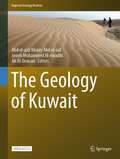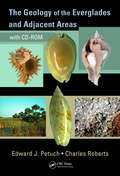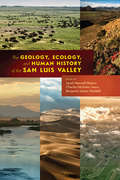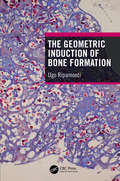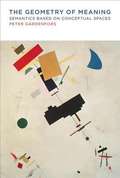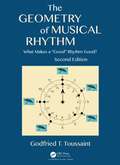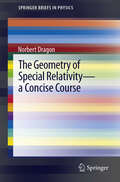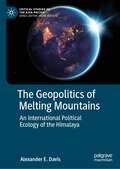- Table View
- List View
The Geology and Tectonic Settings of China's Mineral Deposits
by Franco PirajnoExtensive descriptions of a wide range of key or world-class mineral deposits of China are presented in the context of the country's general geology, tectonic units and mineral systems and their geodynamic evolution within the tectonic framework of the Asian continent. This comprehensive overview, incorporating the latest geological concepts, is the first such coverage written in English by a western expert, and will be of benefit to mineral explorers and miners, as well as to research scientists and students in institutions of higher education. In his compilation of this compendium of Chinese geology and mineral systems, Franco Pirajno draws on first-hand knowledge of China's geology and mineral deposits gained in numerous field visits and research projects with Chinese colleagues from various academic institutions over the past 18 years. First time that a western-based book on China's geology and mineral deposits is published Appropriate for use by the mineral exploration industry Modern English-language geological and mineral deposits information on China Most useful to Western (and Chinese) geoscientists
The Geology of Agate Deposits (SpringerBriefs in Earth System Sciences)
by Andrejs ZarinsThis book examines agate provinces through the lens of plate tectonics, stratigraphy, agatization, and more. It delves into the physical and chemical properties of agate deposits, their environments of formation, and related silica deposits like opal, chert, and petrified wood. Examples, illustrations, maps, and thin-section photos illuminate structural, chemical, and temporal controls. Plate tectonics and lithotectonics are explored to provide a deeper understanding of the volcanic processes behind agate formation.
The Geology of Australia
by David JohnsonThe Geology of Australia provides a vivid and informative account of the evolution of the Australian continent over the last 4400 million years. Starting with the Precambrian rocks that hold clues to the origins of life and the development of an oxygenated atmosphere, it goes on to cover the warm seas, volcanism and episodes of mountain building, which formed the eastern third of the Australian continent. This illuminating history details the breakup of the supercontinents Rodinia and Gondwana, the times of previous glaciations, the development of climates and landscapes in modern Australia, and the creation of the continental shelves and coastlines. Separate chapters cover the origin of the Great Barrier Reef, the basalts in Eastern Australia, and the geology of the Solar System. This second edition features two new chapters, covering the evolution of life on Earth while emphasising the fossil record in Australia, and providing a geological perspective on climate change. From Uluru to the Great Dividing Range, from earthquakes to dinosaurs, from sapphires to the stars The Geology of Australia is a comprehensive exploration of the timeless forces that have shaped this continent.
The Geology of Australia
by David Johnson Robert HendersonThe Geology of Australia provides a vivid and informative account of the evolution of the Australian continent over the last 4400 million years. Starting with the Precambrian rocks that hold clues to the origins of life and the development of an oxygenated atmosphere, it goes on to cover the warm seas, volcanism and episodes of mountain building, which formed the eastern third of the Australian continent. This illuminating history details the breakup of the supercontinents Rodinia and Gondwana, the times of previous glaciations, the development of climates and landscapes in modern Australia, and the creation of the continental shelves and coastlines. Separate chapters cover the origin of the Great Barrier Reef, the basalts in Eastern Australia, and the geology of the Solar System. This second edition features two new chapters, covering the evolution of life on Earth while emphasising the fossil record in Australia, and providing a geological perspective on climate change. From Uluru to the Great Dividing Range, from earthquakes to dinosaurs, from sapphires to the stars The Geology of Australia is a comprehensive exploration of the timeless forces that have shaped this continent.
The Geology of Greece (Regional Geology Reviews)
by Dimitrios I. PapanikolaouThis book introduces the reader to the unique geology of Greece. This country is a natural geology laboratory that can help us understand the present-day active geodynamic processes in the Hellenic orogenic arc, including earthquakes, volcanoes, coastline changes and other processes of uplift and subsidence, as well as the intense erosion, transport and deposition of sediments. Additionally, Greece offers a remarkable geological museum, reflecting the complex history of the area over the last 300 million years. By studying the rocks of Greece, one can discover old oceanic basins, e.g. in the Northern Pindos and Othrys mountains, crystalline rocks of Palaeozoic age, old granitic and volcanic rocks, as well as other sedimentary rocks including fossils from the shallow neritic facies to pelagic and abyssal facies. The younger sediments demonstrate the continuously changing palaeogeography of Greece, with areas of lakes, high plateaus and gulfs that are transformed into new forms of islands, peninsulas or high mountains, etc. All the above subjects are included in the book, which describes the tectonic structure of the geological strata, together with the evolutionary stages of the palaeogeography and geodynamics within the broader Mediterranean context. A special characteristic of the book is the development of the orogenic model of the Hellenides with the application of the tectono-stratigraphic terrane concept in the Tethyan system.
The Geology of Iberia: Volume 2: The Variscan Cycle (Regional Geology Reviews)
by Cecilio Quesada José Tomás OliveiraTaking a new global approach, this unique book provides an updated review of the geology of Iberia and its continental margins from a geodynamic perspective. Owing to its location close to successive plate margins, Iberia has played a pivotal role in the geodynamic evolution of the Gondwanan, Rheic, Pangea, Tethys s.l. and Eurasian plates over the last 600 Ma of Earth's history. The geological record starts with the amalgamation of Gondwana in the Neoproterozoic succeeded by the rifting and spreading of the Rheic ocean; its demise, which led to the amalgamation of Pangea in the late Paleozoic; the rifting and spreading of several arms of the Neotethys ocean in the Mesozoic Era and their ongoing closure, which was responsible for the Alpine orogeny. The significant advances in the last 20 years have attracted international research interest in the geology of the Iberian Peninsula. This volume presents the most comprehensive, careful and updated description of the variscan cycle in Iberia. This volume focuses in the different geological events since the Cambrian-Early Ordovician rift until the late variscan orocline formations including magmatic and metamorphic evolution.
The Geology of Iberia: Volume 3: The Alpine Cycle (Regional Geology Reviews)
by Cecilio Quesada José Tomás OliveiraTaking a new global approach, this unique book provides an updated review of the geology of Iberia and its continental margins from a geodynamic perspective. Owing to its location close to successive plate margins, Iberia has played a pivotal role in the geodynamic evolution of the Gondwanan, Rheic, Pangea, Tethys s.l. and Eurasian plates over the last 600 Ma of Earth's history. The geological record starts with the amalgamation of Gondwana in the Neoproterozoic succeeded by the rifting and spreading of the Rheic ocean; its demise, which led to the amalgamation of Pangea in the late Paleozoic; the rifting and spreading of several arms of the Neotethys ocean in the Mesozoic Era and their ongoing closure, which was responsible for the Alpine orogeny. The significant advances in the last 20 years have attracted international research interest in the geology of the Iberian Peninsula. This volume presents the most comprehensive, and updated description of the Alpine cycle in Iberia. This volume focuses in the different geological events during the Alpine orogeny as well as the lithological succession . This book is of interest not only for scientists of Portugal and Spain but also for geoscientists searching for analogies for oil and gas as well as tourists visiting the main mountain ridges of Iberia such as the Pyrenees.
The Geology of Kuwait (Regional Geology Reviews)
by Ali Al-Dousari Abd el-aziz Khairy Abd el-aal Jasem Mohammed Al-AwadhiThis open access book contains a set of chapters covering all aspects of geosciences related to Kuwait and adjacent regions, including Iran, Saudi Arabia and the Arab Gulf states. It covers basic information about the geology including a wide range of geoscientific disciplines such as marine geology, structural geology, hydrogeology and geophysics related to the region. This book is aimed at researchers and students, as well as professionals in the field of hazard mitigation and petroleum exploration.
The Geology of the Egyptian Nubian Shield (Regional Geology Reviews)
by Zakaria Hamimi Shoji Arai Abdel-Rahman Fowler Mohammed Z. El-BialyThis richly illustrated book provides an overview of the Neoproterozoic Pan-African Belt of Egypt (PABE), which represents the northwestern continuation of the Arabian-Nubian Shield (ANS) and the East African Orogen (EAO). The first chapter offers an introduction to the Turin Papyrus Map and the historical background of the PABE, while the second addresses how the PABE is related to the ANS and EAO. Rock succession of the PABE is dealt with in Chapter 3, while Chapter 4 focuses on Sinai Metamorphic Core Complexes and implications on the break-up of Rodinia. Subsequent chapters discuss a broad range of topics, e.g. ophiolite-dominated suprastructural rocks; volcanosedimentary succession, Neoproterozoic volcanism and volcanic rocks in Egypt; enigmatic issues concerning granite, Dokhan and Hammamat sediments; the lithospheric mantle beneath the Northeast African continent and the mantle section of Neoproterozoic ophiolites from the PABE; sutures, megashears and petrogenetic evolution of the Neoproterozoic rocks of Egypt; and metallic and non-metallic mineral deposits in the PABE, which are covered in extensive detail. The book’s closing chapters discuss the application of remote sensing techniques and anisotropy of magnetic susceptibility (AMS) to decipher the tectonic evolution of the PABE, as well as the use of geophysical data to map structural features and hydrothermal alteration zones in the PABE.
The Geology of the Everglades and Adjacent Areas
by Charles Roberts Edward J. PetuchPainting a complete picture of the history of the Everglades, The Geology of the Everglades and Adjacent Areas brings together theperspectives of various geoscientists to provides an overview of the geology, paleontology, and paleoceanography of the Everglades region. It emphasizes the upper 300 m of the geologic framework of the area and gives insight into the local stratigraphy, geomorphology, lithology, and historical geology. Building upon the geologic nomenclature and stratigraphic sequences set down by the Florida Geological Survey, the book includes redefinitions of some previously poorly known formations, the chronological fine-tuning of other poorly known units, and the description of 7 new members.Designed to be a field guide as well as a reference, the book is illustrated with photographs of exposed geologic sections, stratotype localities, collection sites, and details of interesting fossil beds. It contains 124 full-page illustrations with 69 black and white figures, 43 black and white plates of index fossils, and 12 full color plates of simulated space shuttle images of Florida’s ancient seas and coastlines. This text is accompanied by downloadable resources that feature animated maps along with a Power Point presentation of simulated space shuttle imagery of Eocene-to-Holocene Florida. The book is arranged by geologic time, ranging from the late Eocene, Oligocene, Miocene, Pliocene, and Pleistocene to the Holocene. The authors place lithostratigraphic descriptions of the geologic formations and members into this chronological framework, along with the paleogeography of the seas and lakes within which they were deposited. They also emphasize biostratigraphy with over 1000 index fossils listed and over 400 illustrated. The book brings together information previously spread through innumerable publications, saving you the time and effort it would take to assemble and cross-reference multiple sources.
The Geology, Ecology, and Human History of the San Luis Valley
by Jared Maxwell Beeton Charles Nicholas Saenz Benjamin James WaddellThe Geology, Ecology, and Human History of the San Luis Valley explores the rich landscapes and diverse social histories of the San Luis Valley, an impressive mountain valley spanning over 9,000 square miles that crosses the border of south-central Colorado and north-central New Mexico and includes many cultural traditions. Twenty-six expert scholars and educators—including geologists, geographers, biologists, ecologists, linguists, historians, sociologists, and consultants—uncover the natural and cultural history of the region, which serves as home to the Sangre de Cristo Mountains, the San Juan Mountains, Great Sand Dunes National Park and Preserve, and the Rio Grande headwaters. The first section, “The Geology and Ecology of the San Luis Valley,” surveys the geomorphology, hydrology, animal and plant life, conservation, management, and mining of the valley’s varied terrain. The second section, “Human History of the San Luis Valley,” recounts the valley’s human visitation and settlement, from early indigenous life to Spanish exploration to Hispanic and Japanese settlements. This section introduces readers to the region’s wide range of religious identities—Catholic, Latter-day Saint, Buddhist, Jehovah’s Witness, Amish, and Mennonite—and diverse linguistic traditions, including Spanish, English, Dutch, Danish, Japanese, and Mayan. The final section, “Travel Itineraries,” addresses recreation, specifically fly-fishing and rock climbing. The book provides a comprehensive overview of the endemic flora and fauna, human history of indigenous lifeways, and diverse settlement patterns that have shaped the region. The Geology, Ecology, and Human History of the San Luis Valley will appeal to students and scholars of geology, ecology, environmental history, and cultural history, as well as residents and tourists seeking to know more about this fascinating and integral part of Colorado and New Mexico. Contributors: Benjamin Armstrong, Timothy Armstrong, Deacon Aspinwall, Robert Benson, Lorrie Crawford, Kristy Duran, Jeff Elison, Eric Harmon, Devin Jenkins, Bradley G. Johnson, Robert M. Kirkham, Bessie Konishi, Angie Krall, Richard D. Loosbrock, Richard Madole, A. W. Magee, Victoria Martinez, James McCalpin, Mark Mitchell, R. Nathan Pipitone, Andrew Valdez, Rio de la Vista, Damián Vergara Wilson
The Geometric Induction of Bone Formation
by Ugo RipamontiThe Geometric Induction of Bone Formation describes new biomimetic biomaterials that offer mechanistic osteogenic surfaces for the autonomous and spontaneous induction of bone formation without the addition of osteogenic soluble molecular signals of the transforming growth factor-β supergene family. The chapters frame our understanding of regenerative medicine in primate species, including humans. The goal is to unravel the fundamental biological mechanisms of bone formation unique to non-human and human primates. The broad target audience dovetails with several disciplines both in the academic and private biotech sectors primarily involved in molecular biology, tissue biology, tissue engineering, biomaterial science, and reconstructive, orthopaedic, plastic, and dental surgery. Key Features Includes outstanding images of undecalcified whole mounted sections Summarizes non-human primate research – ideal for clinical translation Reviews methods for creating devices capable of making bone autonomously, i.e. an intrinsically osteo-inductive bioreactor and/or biomaterial Describes the spontaneous induction of bone formation including a whole spectrum of tissue biology, from basic molecular biology to clear-cut morphology and pre-clinical application in non-human primate species Intended for audiences in both academic research and the biotech industry
The Geometrical Beauty of Plants
by Johan GielisThis book focuses on the origin of the Gielis curves, surfaces and transformations in the plant sciences. It is shown how these transformations, as a generalization of the Pythagorean Theorem, play an essential role in plant morphology and development. New insights show how plants can be understood as developing mathematical equations, which opens the possibility of directly solving analytically any boundary value problems (stress, diffusion, vibration. . . ) . The book illustrates how form, development and evolution of plants unveil as a musical symphony. The reader will gain insight in how the methods are applicable in many divers scientific and technological fields.
The Geometries of Visual Space
by Mark WagnerWhen most people think of space, they think of physical space. However, visual space concerns space as consciously experienced, and it is studied through subjective measures, such as asking people to use numbers to estimate perceived distances, areas, angles, or volumes. This book explores the mismatch between perception and physical reality, and describes the many factors that influence the perception of space including the meaning assigned to geometric concepts like distance, the judgment methods used to report the experience, the presence or absence of cues to depth, and the orientation of a stimulus with respect to point of view. The main theme of the text is that no single geometry describes visual space, but that the geometry of visual space depends upon the stimulus conditions and mental shifts in the subjective meaning of size and distance.In addition, The Geometries of Visual Space:*contains philosophical, mathematical, and psychophysical background material;*looks at synthetic approaches to space perception including work on hyperbolic, spherical, and Euclidean geometries;*presents a meta-analysis of studies that ask observers to directly estimate size, distance, area, angle, and volume;*looks at the size constancy literature in which observers are asked to adjust a comparison stimulus to match a variety of standards at different distances away;*discusses research that takes a multi-dimensional approach toward studying visual space; and*discusses how spatial experience is influenced by memory.While this book is primarily intended for scholars in perception, mathematical psychology, and psychophysics, it will also be accessible to a wider audience since it is written at a readable level. It will make a good graduate-level textbook on space perception.
The Geometry of Celestial Mechanics
by Hansjörg GeigesCelestial mechanics is the branch of mathematical astronomy devoted to studying the motions of celestial bodies subject to the Newtonian law of gravitation. This mathematical introductory textbook reveals that even the most basic question in celestial mechanics, the Kepler problem, leads to a cornucopia of geometric concepts: conformal and projective transformations, spherical and hyperbolic geometry, notions of curvature, and the topology of geodesic flows. For advanced undergraduate and beginning graduate students, this book explores the geometric concepts underlying celestial mechanics and is an ideal companion for introductory courses. The focus on the history of geometric ideas makes it perfect supplementary reading for students in elementary geometry and topology. Numerous exercises, historical notes and an extensive bibliography provide all the contextual information required to gain a solid grounding in celestial mechanics.
The Geometry of Kerr Black Holes (Dover Books on Physics)
by Barrett O'NeillThis unique monograph by a noted UCLA professor examines in detail the mathematics of Kerr black holes, which possess the properties of mass and angular momentum but carry no electrical charge. Suitable for advanced undergraduates and graduate students of mathematics, physics, and astronomy as well as professional physicists, the self-contained treatment constitutes an introduction to modern techniques in differential geometry. The text begins with a substantial chapter offering background on the mathematics needed for the rest of the book. Subsequent chapters emphasize physical interpretations of geometric properties such as curvature, geodesics, isometries, totally geodesic submanifolds, and topological structure. Further investigations cover relativistic concepts such as causality, Petrov type, optical scalars, and the Goldberg-Sachs theorem. Four helpful appendixes supplement the text.
The Geometry of Meaning
by Peter GärdenforsIn The Geometry of Meaning, Peter Gärdenfors proposes a theory of semantics that bridges cognitive science and linguistics and shows how theories of cognitive processes, in particular concept formation, can be exploited in a general semantic model. He argues that our minds organize the information involved in communicative acts in a format that can be modeled in geometric or topological terms -- in what he terms conceptual spaces, extending the theory he presented in an earlier book by that name. Many semantic theories consider the meanings of words as relatively stable and independent of the communicative context. Gärdenfors focuses instead on how various forms of communication establish a system of meanings that becomes shared between interlocutors. He argues that these "meetings of mind" depend on the underlying geometric structures, and that these structures facilitate language learning. Turning to lexical semantics, Gärdenfors argues that a unified theory of word meaning can be developed by using conceptual spaces. He shows that the meaning of different word classes can be given a cognitive grounding, and offers semantic analyses of nouns, adjectives, verbs, and prepositions. He also presents models of how the meanings of words are composed to form new meanings and of the basic semantic role of sentences. Finally, he considers the future implications of his theory for robot semantics and the Semantic Web.
The Geometry of Meaning: Semantics Based on Conceptual Spaces
by Peter GardenforsA novel cognitive theory of semantics that proposes that the meanings of words can be described in terms of geometric structures. In The Geometry of Meaning, Peter Gärdenfors proposes a theory of semantics that bridges cognitive science and linguistics and shows how theories of cognitive processes, in particular concept formation, can be exploited in a general semantic model. He argues that our minds organize the information involved in communicative acts in a format that can be modeled in geometric or topological terms—in what he terms conceptual spaces, extending the theory he presented in an earlier book by that name. Many semantic theories consider the meanings of words as relatively stable and independent of the communicative context. Gärdenfors focuses instead on how various forms of communication establish a system of meanings that becomes shared between interlocutors. He argues that these “meetings of mind” depend on the underlying geometric structures, and that these structures facilitate language learning. Turning to lexical semantics, Gärdenfors argues that a unified theory of word meaning can be developed by using conceptual spaces. He shows that the meaning of different word classes can be given a cognitive grounding, and offers semantic analyses of nouns, adjectives, verbs, and prepositions. He also presents models of how the meanings of words are composed to form new meanings and of the basic semantic role of sentences. Finally, he considers the future implications of his theory for robot semantics and the Semantic Web.
The Geometry of Musical Rhythm: What Makes a "Good" Rhythm Good?, Second Edition
by Godfried T. ToussaintThe original edition of The Geometry of Musical Rhythm was the first book to provide a systematic and accessible computational geometric analysis of the musical rhythms of the world. It explained how the study of the mathematical properties of musical rhythm generates common mathematical problems that arise in a variety of seemingly disparate fields. The book also introduced the distance approach to phylogenetic analysis and illustrated its application to the study of musical rhythm. The new edition retains all of this, while also adding 100 pages, 93 figures, 225 new references, and six new chapters covering topics such as meter and metric complexity, rhythmic grouping, expressive timbre and timing in rhythmic performance, and evolution phylogenetic analysis of ancient Greek paeonic rhythms. In addition, further context is provided to give the reader a fuller and richer insight into the historical connections between music and mathematics.
The Geometry of Spacetime: A Mathematical Introduction to Relativity Theory (Graduate Texts in Physics)
by Rainer OloffThis book systematically develops the mathematical foundations of the theory of relativity and links them to physical relations. For this purpose, differential geometry on manifolds is introduced first, including differentiation and integration, and special relativity is presented as tensor calculus on tangential spaces. Using Einstein's field equations relating curvature to matter, the relativistic effects in the solar system including black holes are discussed in detail. The text is aimed at students of physics and mathematics and assumes only basic knowledge of classical differential and integral calculus and linear algebra.
The Geometry of Special Relativity - a Concise Course
by Norbert DragonIn this concise primer it is shown that, with simple diagrams, the phenomena of time dilatation, length contraction and Lorentz transformations can be deduced from the fact that in a vacuum one cannot distinguish physically straight and uniform motion from rest, and that the speed of light does not depend on the speed of either the source or the observer. The text proceeds to derive the important results of relativistic physics and to resolve its apparent paradoxes. A short introduction into the covariant formulation of electrodynamics is also given. This publication addresses, in particular, students of physics and mathematics in their final undergraduate year.
The Geopolitics of Hydrogen: Volume 1: European Strategies in Global Perspective (Studies in Energy, Resource and Environmental Economics)
by Rainer Quitzow Yana ZabanovaThis open access book is a comprehensive exploration of European hydrogen policy, examining its development at both the EU level and in key Member States, while also considering the geopolitical implications of the emerging hydrogen landscape. The editors begin by framing Europe's position within the global hydrogen economy and present an analytical framework for assessing EU and Member State strategies within this context. The book delves into the evolution of EU hydrogen policy since the launch of its hydrogen strategy in 2020, shedding light on significant developments and how they have been influenced by events like Russia's invasion of Ukraine. It then proceeds with in-depth chapters dedicated to key EU Member States and Norway. Each country chapter examines domestic and international hydrogen policies, offering insights into important stakeholder interests, as well as the broader energy and foreign policy considerations shaping the evolving policy landscape. Special attention is given to the international dimension of these strategies, encompassing bilateral and multilateral engagements. In the final chapter, the editors analyze the diverse national strategies and their drivers and discuss their implications for the development of a European hydrogen economy and the role of the EU as a major global player in this market. By examining the variations across Member States, the book provides valuable insights into the factors influencing progress in the hydrogen sector, both in Europe and globally. This book is a resource for policymakers, researchers, and industry professionals seeking a comprehensive understanding of European hydrogen policy and its geopolitical implications. It illuminates the complex dynamics between EU-level strategies and the approaches adopted by individual Member States, ultimately contributing to a broader comprehension of Europe's position within the global hydrogen arena.
The Geopolitics of Melting Mountains: An International Political Ecology of the Himalaya (Critical Studies of the Asia-Pacific)
by Alexander E. DavisThe book addresses the urgent need for rethinking the geopolitics and ecology in the Himalaya, by emphasising the entanglements between these two factors. Most international relations analyses of the Himalaya emphasize the central role of the region’s states and their great power struggles. By reducing the region to its state actors, however, we miss the intense more-than-human diversity of the region, and the crucial role that the mountains play in the global environment. In doing so, the book makes a major contribution to international relations theory by drawing on insights from international political ecology. It first theorises international political ecology and examines the Himalaya as a global region, before moving looking at the international aspects of political ecology in the Himalaya through key areas of the mountains where international politics and ecology are deeply, inextricably linked. It presents three detailed case studies of different environmental and political issues in the Himalaya: icecaps (the India-China-Pakistan boundary dispute in the western Himalaya), foothills and forests (the Nepal-Bhutan-Sikkim borderlands), and rivers (the India-China Bangladesh dispute over the Brahmaputra River basin). Each case study draws on a mix of source materials including fieldwork, government sources, foreign policy discourse, Himalayan ethnographies, and environmental and ecological sciences scholarship.
The Geopolitics of Space Exploration (Springer Praxis Books)
by Marcello SpagnuloThis is the tale of the modern Space Age, detailing all the risks, rewards and rivalries that have fueled space exploration over the decades. Jump into a world of ambitious entrepreneurs and determined spacefaring nations, of secret spy satellites and espionage, of all the cooperative and competing interests vying for dominance in ways little known to the public. Written by an Italian aeronautical engineer with over thirty years of experience in government and private industry, this English translation explains how and why the game has fundamentally evolved and where it is headed next. Exploring such topics as GPS and cyberspace, the economics of private and public industry and the political motivations of emerging spacefaring powerhouses like China, this book is an engaging foray into the ongoing battle for our terrestrial home through extraterrestrial means.
The Georgian Star: How William and Caroline Herschel Revolutionized Our Understanding of the Cosmos (Great Discoveries) (Great Discoveries #0)
by Michael Lemonick"A bright, shiny gift to popular-science collections."--Booklist Trained as a musician, amateur scientist William Herschel found international fame after discovering the planet Uranus in 1781. Though he is still best known for this finding, his partnership with his sister Caroline yielded other groundbreaking work that affects how we see the world today. The Herschels made comprehensive surveys of the night sky, carefully categorizing every visible object in the void. Caroline wrote an influential catalogue of nebulae, and William discovered infrared radiation. Veteran science writer Michael D. Lemonick guides readers through the depths of the solar system and into his subjects' private lives: William developed bizarre theories about inhabitants of the sun; he procured an unheard-of salary for Caroline from King George III even as he hassled over the funding for an enormous, forty-foot telescope; and the siblings feuded over William's marriage but eventually reconciled.






